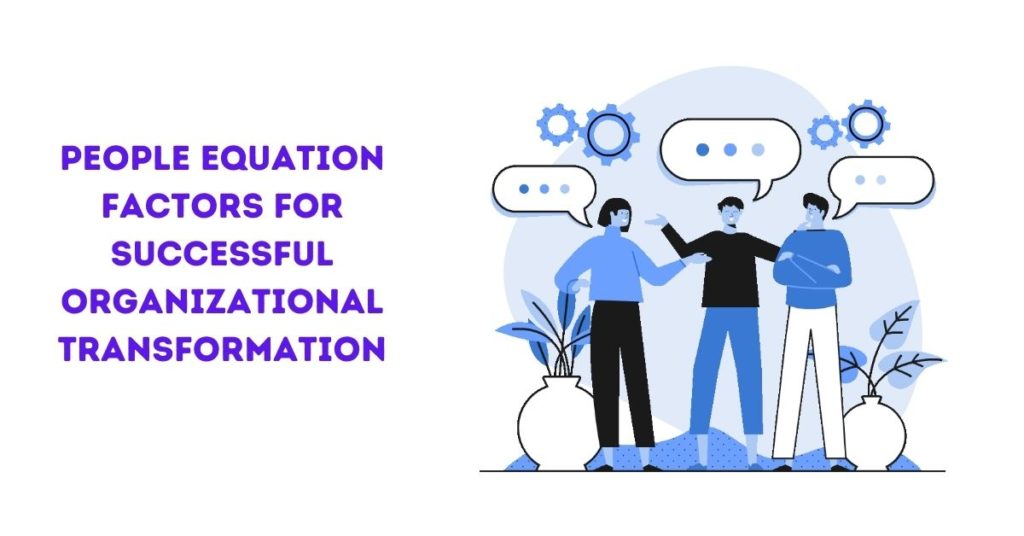What is the key to a successful organizational change? McKinsey’s most recent research has revealed that there are several key success factors. An analysis of large numbers of companies found success indicators that align with what you might expect. These include keeping executives on track, allocating capital assets and setting clear goals.
Organizations that thrive in change are those that understand and implement practices that respect the people equation are what truly make them stand out. In this post, I’m going to break down three key findings from McKinsey’s research and parse out how the social psychology (aka the “people equation”) of these factors contributes to successful change/transformation initiatives.
Human connection outranks resource allocation in this key instance
Individual performance dialogs ranked fourth among the nine best predictors for a successful organizational transformation. Talking with your team about their contributions and growth has been shown to increase success rates by 1.5. These conversations were more important than planning/budgeting and IT resource allocation, talent allocation, capital funding, and IT resource allocation.
The People Equation:
People desire to have meaningful conversations with their leaders.
This isn’t rocket science. Employees value productive and empowering conversations with their leader. Note: Performance dialog does not necessarily mean verbal beating-down. It all starts with regular check-ins.
Are you looking for ways to build a stronger connection with your team? This post will help you celebrate “wins” in one-on-one meetings. Also, this post will help you be truly connected when you meet.
Setting the Bar High Works – If These Conditions Are
Research on goal setting (and the misguided mythology of “go big or home” that often accompany them) shows that ambitious goals can be powerful. Recent McKinsey research supports this assertion. According to the study authors, “Setting a financial target for the entire transformation is an important step to take. It sets the tone for the program and what’s possible. People tend to achieve high expectations if companies have high expectations.”
This statement contains a large asterisk. Goals will only be achieved if there are two conditions: people must understand their roles and information needs to get disseminated clearly.
Employees must be involved and it is important that they see their part in the overall transformation story. The McKinsey research team wrote that people need to know what these goals are for their daily jobs and what they can expect to do differently. “If they don’t understand how the transformation will affect their behavior and how it gets done, then their behavior and how they work will not change.” Remember the importance of 1:1 performance conversations, which we discussed above? This also ties in with the previous.
The information must be passed down to all employees. This is not always the case. Survey results show a perception gap. Senior leaders believe their goals for transformation have been made available to all employees, nearly 20% more than those in other roles. We can’t let this happen in your company. . .” “Me? They are not supposed to hear from YOU. . .”
The People Equation:
It doesn’t necessarily mean that everyone understands it, just because senior leaders do.
During communications coaching sessions, I remind leaders that just because they have settled on the information about a new initiative doesn’t mean everyone else is. Leaders need to make connections between the dots because the grapevine can be a notoriously inaccurate source of information. You might also consider your communications as “curation”. What messages do you send to the wider organization? This is especially true when communicating with people who do not report to you directly.
Influencers: Beyond role models to Thought Partners
Since years, I have been covering the importance of influential employees in the success and failure of transformation efforts. Influencers still matter and are a very important part of the transformation process. McKinsey’s most recent research shows that influencers can increase success rates by 1.4x. There are nuances to these findings as well. When they were “thought partners” with front-line leaders, opinion leaders were at their most influential, helping them understand the impact of the changes. Surprisingly this “walk along” approach was more effective than role modeling the behaviors and mindsets that support the change.
The People Equation:
To be a “thought-partner” you must listen to others.
Communicating with peers.
This research shows that it is not enough for an influential role model to simply “walk the talk” and demonstrate a new set standards. To make the change take root, influential peers must also be open to setting up shop alongside those who do the actual work. They should then be open to listening to their frustrations, ideas, and suggestions while they are making the changes. Too often, executives make financial decisions that don’t translate to the “shop floor”, no matter what your company’s “shop”.
A thought partner is someone who can tell when you should shut up, how to get derail convos back on track, and uses encouraging language to build positive relationships. These suggestions do not relate to one’s technical or industry knowledge.
Technology, capitalization and talent acquisition all play a role in the success of organizational transformations. However, savvy leaders know that money and strategy can only take you so far. People are the true difference in change initiatives. Are you and your leadership team up for these elements?



